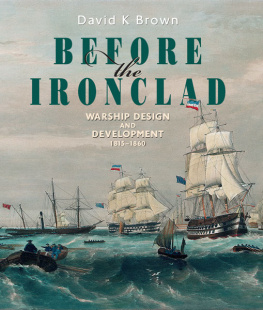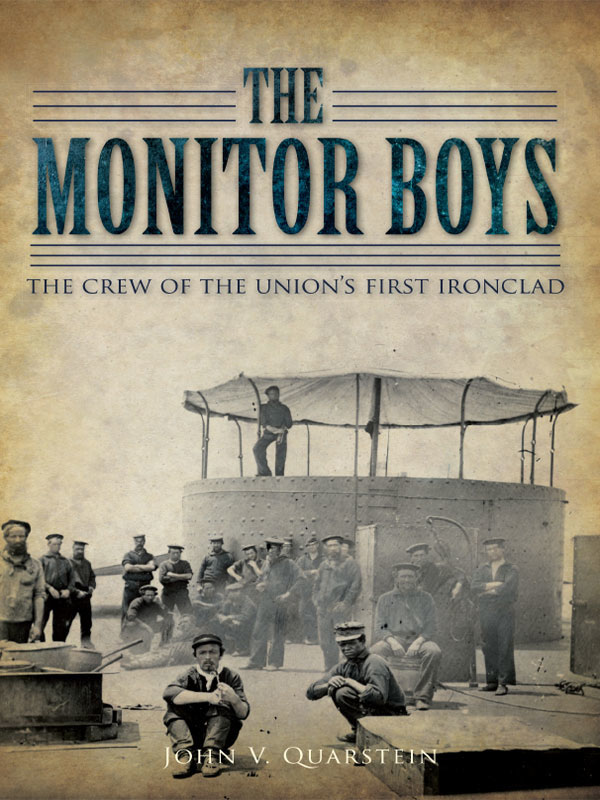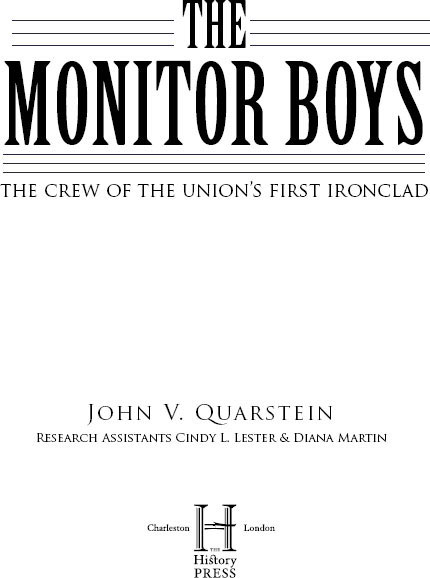Published by The History Press
Charleston, SC 29403
www.historypress.net
Copyright 2011 by John V. Quarstein
All rights reserved
Front cover: View of USS Monitor. From left to right: Robinson W. Hands, Louis Stodder, Albert B. Campbell and William Flye. Photograph by J. Gibson, 4 July 1862.
Courtesy of The Mariners Museum.
First published 2011
e-book edition 2013
Manufactured in the United States
ISBN 978.1.62584.227.5
Library of Congress Cataloging-in-Publication Data
Quarstein, John V.
Monitor boys : the crew of the Unions first ironclad / John V. Quarstein.
p. cm.
Includes bibliographical references and index.
print edition ISBN 978-1-59629-455-4
1. Monitor (Ironclad) 2. Monitor (Ironclad)--Pictorial works. 3. Monitor (Ironclad)--Biography. 4. Sailors--United States--Biography. 5. United States. Navy--Biography. 6. Hampton Roads, Battle of, Va., 1862. 7. United States--History--Civil War, 1861-1865--Naval operations. 8. Seafaring life--United States--History--19th century. I. Title.
E595.M7Q83 2011
973.752--dc22
2010052980
Notice: The information in this book is true and complete to the best of our knowledge. It is offered without guarantee on the part of the author or The History Press. The author and The History Press disclaim all liability in connection with the use of this book.
All rights reserved. No part of this book may be reproduced or transmitted in any form whatsoever without prior written permission from the publisher except in the case of brief quotations embodied in critical articles and reviews.
Contents
Foreword
Id like to describe a scene for you.
It is early June in 1862. The celebrated ironclad USS Monitor is patrolling the James River in Tidewater Virginia on a less than glamorous duty. Entries in the ships logbook that June are a litany of temperatures that would be familiar to anyone who has ever been near the James River at that time of year.
Acting Lieutenant William Flye wrote on 2 June that at 1 pm thermometer stood 142 inside the galley, the door being open and the blowers of the engine being in action. The heat continued to be oppressive while the engine driving the blowers became overworked and finally gave up. On 13 June, Fireman George Geer wrote home to his wife Martha, We took the Impriture [sic] of several parts of the ship or rather I did as I have charge of the Thurmomitor [sic] and found in my Store Room which is fartherest [sic] stern it stood at 110 in the Engine room 127 in the Galley where they Cook and after the fire was out 155 on the Berth Deck where we Sleep 85so you can see what a hell we have.
Though a thunderstorm later in the week cooled things off a bit, things would get worse. At 1:30 a.m. on 23 June, the men discovered a fire around the stovepipe of the galley. Geer wrote that they were able to extinguish it, but there was enough damage to knock the galley out of commission for a few weeks. He did not feel much like eating, though. He was suffering from jaundice.
Then the photographer showed up.
The photos taken by James Gibson on 9 July 1862, take on new meaning when you know what the men on the Monitor had just been through. The battle they had fought recently had not been with Confederate forces, but rather with oppressive heat, swarms of mosquitoes, a broken engine and terrible ennui. Even the imperious genius John Ericsson, who rarely found fault with any of his own creations, voiced his sympathies for the men on board, writing to his friend, Chief Engineer Isaac Newton, that he could not imagine anything more monotonous and disagreeable than life on board the Monitor, at anchor in the James River, during the hot season. The expressions on the mens faces in Gibsons photos, which can be found in Admiral John Wordens personal photo album, bear that out. But you wont find George Geer in any of the photos. He was too sick to come on deck.
We can re-create this scene thanks to the wealth of information on the cheesebox on a raft that can be found in The Mariners Museum Library and Archives and in archives, libraries, historical societies and private collections around the world.
The artifacts recovered from NOAAs Monitor National Marine Sanctuary take on new meaning when paired with letters, drawings and photographs. Here in this intersection of archive and artifact, mute metal pieces strive to give voice to the men who used themand help to tell their stories and paint their pictures about their history, their discovery and recovery.
But they cannot always speak on their own. Historian John Quarstein has taken all of this information and more and brought the self-proclaimed Monitor Boys to life once again. A master storyteller, John has found their voices and has helped them tell their stories.
So dive into the world of the Monitor and meet William Flye, George Geer and the rest of the men who risked everything by going to sea in the celebrated cheesebox on a raft and became the hope of a nation wracked by war.
Meet the Monitor Boys.
Anna Holloway
Vice-President, Museum Collections & Programs
Curator, USS Monitor Center
The Mariners Museum
Preface
I remember the day the Monitors turret finally returned to Hampton Roads like yesterday. Positioned atop a barge as she put into shore near The Mariners Museum Lions Bridge, I declared then that she looked from afar as the Monitor would have looked 140 years before. As the turret was moved along a road to her conservation tank, I took a chance and touched her side. I felt an overwhelming connection with this unique warship that I had never felt before. Since that moment, I marveled at all the men who had been associated with the ship and desired to learn all I could about them. It was an urge that brought me to write this book.
When the turret arrived, I was already serving as a consultant on the Monitor Center Project developing exhibit names and researching the CSS Virginia. When I was younger, I was enthralled by the Battle of the Ironclads and favored the Confederate ironclad. Nevertheless, my work with The Mariners Museum gave me a greater appreciation for the Monitor as I was able to stand inside the turret, touch the Dahlgrens and see unique archaeological discoveries. All of this made me think more about the men who served aboard this novel warship.
Even though many books have been written about the Monitor, I realized that no comprehensive study had been accomplished detailing the crew and their lives aboard the Monitor. Irwin Berent published his outstanding research for NOAA in 1982. Consequently, I compiled all the available service records and other related documents to produce a biography of each crew member. Simultaneously with this effort, I constructed a detailed chronology of the Monitor and her crews service. All of this information was then organized into appendices.
When I sat down to write the narrative, I recognized that I had to tell the complete story, however, and, whenever possible, interject what various officers and crew thought about in the life on the Monitor.












